How to whip egg whites & obtain high volume with stability
.

.
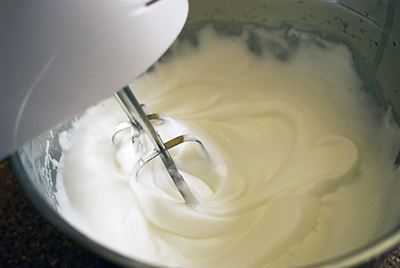
(Soon as you can make strokes in the whites, put the last lot of sugar in.)
.
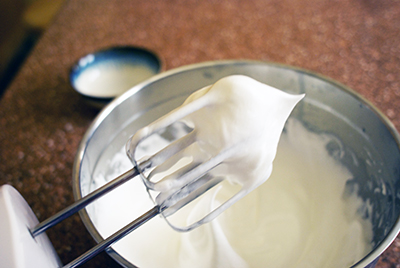

.

.

(Soon as you can make strokes in the whites, put the last lot of sugar in.)
.

.
Backtracking humongously here, but here are some pictures from before Easter.
~ . ~ . ~ . ~ .~ . ~ .~ . ~ .~ . ~ .~ . ~ .~ . ~
There are seven Japanese mums at my son’s school, & we all got together to raise funds for the Japan earthquake & tsunami relief. We did a sushi & cake sale in the school yard, & I of-course contributed by baking cookies & cakes.
.
Upon setting about doing this, I had a clear criteria to solve. Perhaps it’s the old graphic designer in me, but I love brainstorming. So here’s what I considered:
~ I knew I wanted a Japanese theme to them. ~ It had to appeal to primary school children & their mums. ~ It also must be time & cost effective for maximum return. (The going-rate for cake spendage is 20p to a £1 at a standard school cake sale, so for the pricing to be set so low, the cost of ingredients must stay minimal…) ~ And most importantly, explicitly with NO nuts as the school has a nut-free policy.
.
After a quick sesh with my thinking cap on, I figured the best way is to bake cookies but also add value to them by imprinting famous childrens characters. Hello Kitty to appeal to girls, & Pikachu (Pokémon) for boys. As for the cookie recipe, I used the tried & tested Nontan one that I wrote about previously on this blog.
.
To imprint the characters, here’s what I did:
.
(I used my tart tin as a cookie mold to get the fluted rim.)
(Pre-packaged in a bag for quick sale. Small handmade Japan flag sticker for added touch & charity feel. Lucky that the Japan flag is just a red circle! I wouldn’t have done this if the flag design was complicated! ie; U.S.A!)
(Cookie came big in five inch diameter! But was sold only for a pound! Bargain!! If at my market, I would’ve sold them at £1.50 I reckon!)
.
I made about 55 of these, & they sold within 7 minutes. I didn’t anticipate that most mums would be buying more than one each. ~ I should’ve made more…!!? ^^
.
One of the many baking questions I get asked is how to scale a cake recipe to fit another size or shaped pan.
.
There is an universal formula you can use:
.
(volume of the preferred tin) ÷ (volume of the original tin)
.
x . x . x . x . x . x . x . x . x . x . x . x . x . x . x . x . x . x . x . x . x . x . x
.
For this, you need to find out the volume of the two tins.
The formulas to work out the volume of a pan according to shapes are the following:
.
ROUND
(3.14 x half the diameter x half the diameter x height)
.
SQUARE or RECTANGLE
(length x width x height)
.
NOVELTY CAKE TIN
First work out the volume of tin by weighing how much water goes in. Water is 1g = 1 cm³
(The mass of 1 cubic centimetre water at 3.98°c equal to a gram. (it’s the temperature at which it is at maximal density roughly). So we can use that number you’ve weighed as the measure of volume.
.
MULTI-CAVITY TIN (like a muffin pan)
Again, work out the volume by pouring water in one cavity, & multiply that with how many cavities there are. Weigh it in grams, & use that number as the volume.
.
x . x . x . x . x . x . x . x . x . x . x . x . x . x . x . x . x . x . x . x . x . x . x
.
Here are two examples:
.
To convert from an 8″ ROUND cake tin (with 2″ height) to 10″ ROUND cake tin (with 3″ height) you’d do this:
.
(3.14 x half the diameter x half the diameter x height) ÷ (3.14 x half the diameter x half the diameter x height)
.
(3.14 x 5 x 5 x 3) ÷ (3.14 x 4 x 4 x 2) = 2.34375
So here we now know that we need to multiply the recipe by 2.4 times.
.
But if the height of the pans are the same, use this simpler formula:
(dimension of preferred tin ÷ dimension of original tin) x (dimension of preferred tin ÷ dimension of original tin)
For example,
(10÷8) × (10÷8) = 1.25 x 1.25 = 1.5625
So here we now know that we need to multiply the recipe by 1.6 times.
.
_ . _ . _ . _ . _ . _ ._ . _ . _ ._ . _ . _ ._ . _ . _ ._ . _ . _ ._ . _ . _ ._ . _ .
.
To convert an 8″ ROUND cake tin A to 10″ SQUARE cake tin B (when height is the same):
.
(length x width) ÷ (3.14 x half the diameter of A x half the diameter of A)
.
(10 x 10 ) ÷ (3.14 x 4 x 4) = 1.99
So here we now know that we need to multiply the recipe by 1.99 times. (I like to round it to 2)
.
x . x . x . x . x . x . x . x . x . x . x . x . x . x . x . x . x . x . x . x . x . x . x
.
Please note:
– If both tins in question are of same height, you don’t need to measure the height for each.
– The examples are in inches, but of-course the same formula works in centimeters too!
– When I get long answers like 1.5625, I personally like to round it UP to 1.6.
– Although the oven temperature should remain the same for both occasions, the baking-time will change.
.
x . x . x . x . x . x . x . x . x . x . x . x . x . x . x . x . x . x . x . x . x . x . x
.
It’s all probably elementary bit of maths for you all, but for me it certainly isn’t! There is a reason why I’m a baker & not a mathematician…
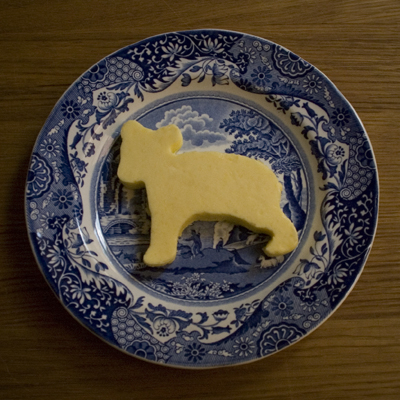 (Bear cub – Homemade butter cut out with cookie cutter.)
(Bear cub – Homemade butter cut out with cookie cutter.)
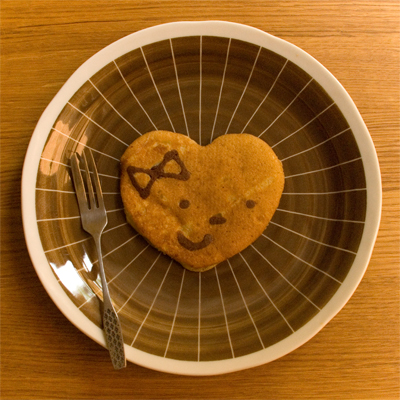 (Heart shape buttermilk pancake)
(Heart shape buttermilk pancake)
.
About time for some recipes from yours truly. xx
.
First, I would like to write about how easy it is to make butter in your very own home. Not just any butter, but a deliciously creamy one, quite unlike any that you’ve had before, I promise. And all from JUST one ingredient; double cream (& salt to taste), which you JUST over-whip until the liquid has separated & leaves you with the semi-solid, which is the butter (more precisely, butterfat). Stupendously easy right? Told you!! ^^
.
And here’s the revelation. The left over liquid is, guess what? Buttermilk!!!! So don’t throw it away because we are using it for our pancakes later.
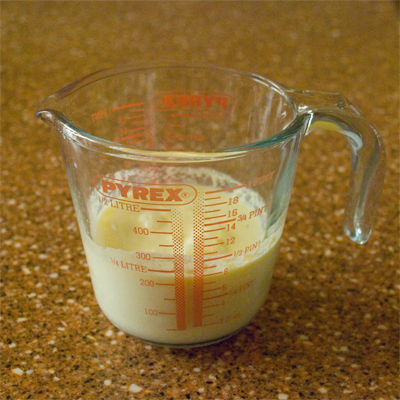 (Buttermilk extracted from double cream!!)
(Buttermilk extracted from double cream!!)
.
Here’s what you’ll need to make butter:
.
And to make it:
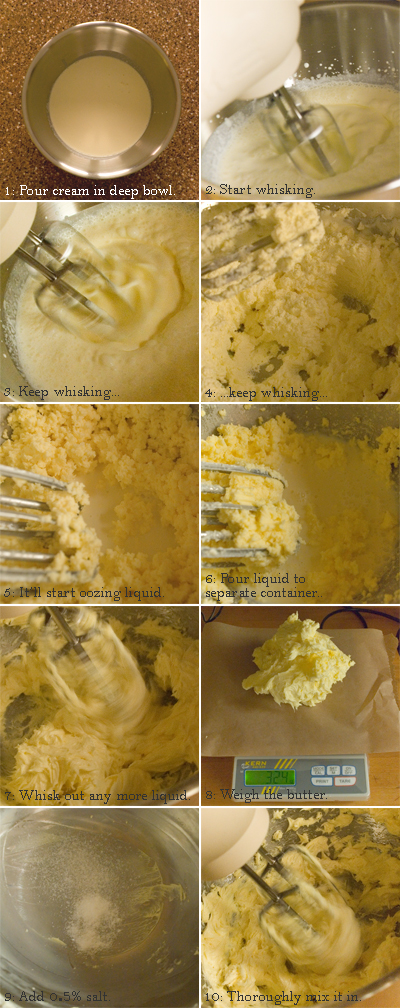
To store, you can just scoop it in a Tupperware & refrigerate, or, if you like, you can roll it to 1.5cm thickness or more in-between greaseproof paper like the picture below, then freeze it for a while (1-2 hours) to make it hard to cut shapes using cookie cutters!!! (… it is best to use simple shapes that don’t have intricate corners. Also, you might want to use a cooks’ blow torch to ease them out of the mold.)
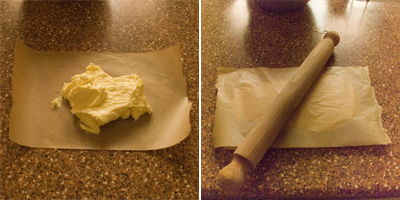
Guide notes:
.
x . . . x . . . x . . . x . . . x . . . x . . . x . . . x . . . x . . . x . . . x . . . x
.
Next, let’s make some fun looking pancakes!
In the recipe below, I have used silicone egg rings to make shapely pancakes. And also had some fun drawing on them. Ofcourse, you can approach this the usual/ easier/ quicker way by just freehand scooping & pouring! – And as for the recipe itself, it produces very moist pancakes that is very (very) moreish, I can assure you it’ll disappear from your plate in nooooo time… Ever since I made this recipe, we always have buttermilk in our fridge for a quick fix up!
.
x . . . x . . . x . . . x . . . x . . . x . . . x . . . x . . . x . . . x . . . x . . . x
.
Buttermilk pancake recipe:
.
Ingredients:
You’ll need the following things:
.
Method:

Guide notes:
.
Some more designs:
.
This one is an evolving message on a pancake as they eat! The surprise is right at the bottom!
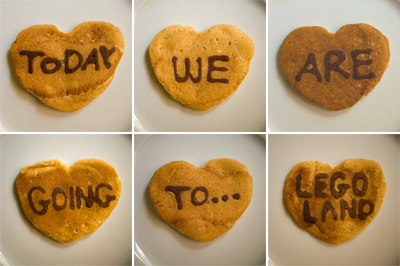
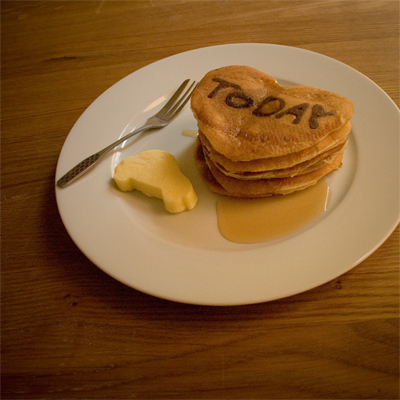 (… With car-shaped butter!) You have to pipe the letters mirrored – which can get confusing!! (notice the ‘Y’ in ‘today’?)
(… With car-shaped butter!) You have to pipe the letters mirrored – which can get confusing!! (notice the ‘Y’ in ‘today’?)
.
And there’s the three bears: .
.
This one, I used my stencil to dust a bit of icing.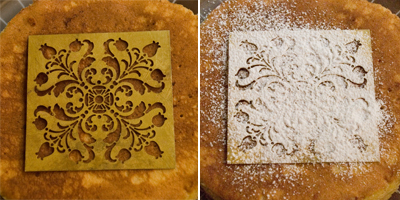
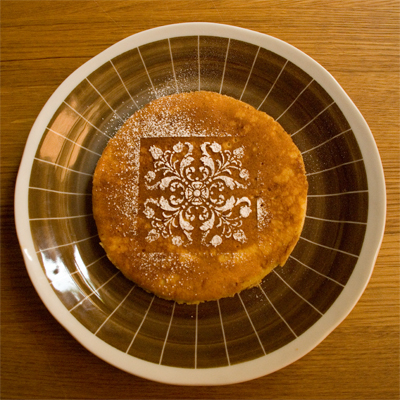 .
.
More playing around…
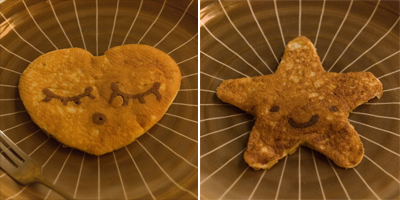 .
.
And finally, a picture of a squirrel butter, which ends my longest ever recipe post!!!!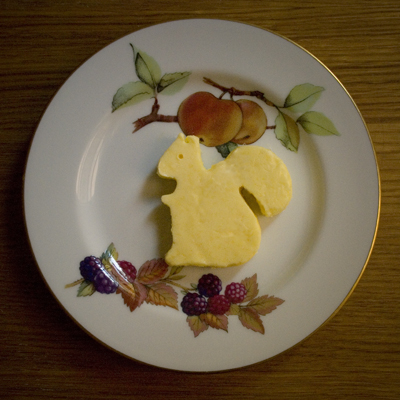
 (I made three bottles – with vodka, brandy & rum to experiment. In 5 weeks time I’ll know which one came out best!)
(I made three bottles – with vodka, brandy & rum to experiment. In 5 weeks time I’ll know which one came out best!)
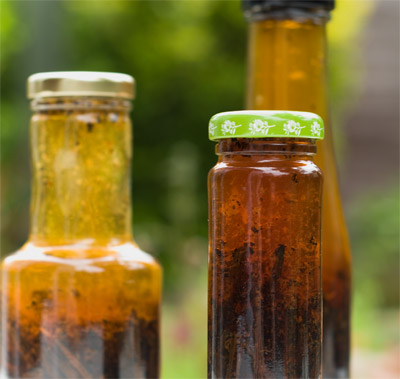
(I used clear glass jars despite the “instructable” suggesting to use dark glass to protect the extract from direct sun exposure. I’ll put them in a dark cupboard instead!)
.
Do you have half-consumed bottles of vodka (or brandy or rum) sitting in your cupboard that’s been long forgotten about? Well, here’s an idea. You can infuse them with vanilla pods to concoct yourself a superior homemade vanilla extract.
.
Y’see, now that I’m walking around the house with a baby sling instead of partying like an animal (!?), I decided that I might aswell turn these forgotten alcoholic beverages to good use, by baking it in to cakes & stuff. Much more useful – having a boozy vanilla extract instead…
.
The supermarket price VS the cost to home-make:
A bottle of bog standard vanilla extract off the supermarket shelf can be pricey at around £4.00 for a measly 100ml. As for purchasing just ONE pod, it ranges from £1.44 for the cheapest to an extortionate £2.26.
.
I figured out that this project could turn out a tad expensive. The recipe requires 30g of pods (8 to 10 pods) to 250ml. Thats hell-of-a-lot of pods… If you buy pods off-the-shelf for this, it’s like over 14 pounds for the pods, then you gotta think of how much the alcohol would cost on top of that!
.
Luckily, my homemade brew costs a lot less in comparison, as my vanilla pods are cheap (I got mine from a wholesaler at £75 for 1kg), & as for the alcohol, I worked out that it costs just over £1 for 100ml. To make a 250ml, it’ll probably cost me just under 3 pounds.
.
For the recipe, I followed the “instructable” & its author’s website it links to. (“Instructable” is a website where passionate people share what they do & how they do it, & learn from others. – I love whiling away my time browsing the often bizarre & original food ‘instructables’. The recent ‘I-wish-I-came-up-with-that-idea’ I found was to use a playdough extruder to make long square rods of cookie dough to make pixel patterned cookies!!)
.
The instructable goes to great lengths to document the recipe for vanilla extract, & I’m not even gonna try to emulate.
.
But here’s the RECIPE, nut-shell version:
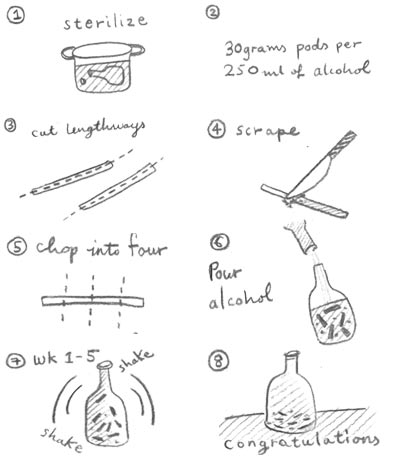
Note: Shake the bottle if you want the seeds/ beans in your recipe. And top-up with more alcohol if the pod-skin gets exposed. After 6 months you can take the pod-skins out as the extraction has finished by then.
.
UPDATE 17.07.08
using vodka for the extraction was best. The rum/ brandy, the distinct smell of the alcohol overpowered the delicate vanilla scent. Read the results of the vanilla extract experiment here.

© Coco&Me 2025 – All writing & pictures remain the property of Coco&Me & cannot be used without permission